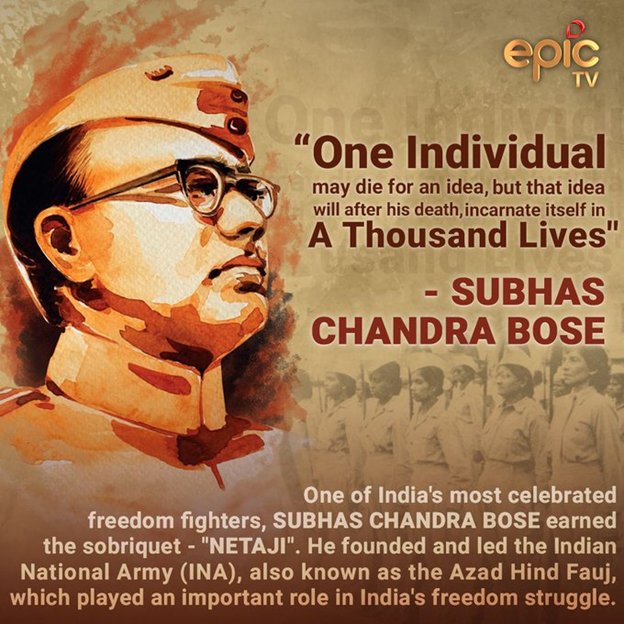How Bose’s INA helped India win independence
Context- Subhas Chandra Bose was born on January 23, 1897. His Indian National Army (INA), also called the Azad Hind Fauj (literally Free Indian Army), faced the British on the battlefield during World War II. While militarily unsuccessful, the INA played a crucial role in India’s struggle for independence.
Bose takes over the INA
- The Indian National Army (INA) was established on February 17, 1942, following the British surrender to Japanese forces in Singapore.
- The INA was primarily made up of Indian prisoners of war (PoWs) who were captured during the Japanese campaign in Southeast Asia. The Japanese believed that an indigenous Indian force would be a potent tool in their planned invasion of India.
- However, by December, the INA was in chaos, lacking direction and leadership. The situation changed with the arrival of Subhas Chandra Bose in July 1943. After seeking assistance from both the Nazis and the Japanese for India’s independence, Bose took command of the 12,000-strong INA on July 4.
- Bose inspired his troops by stating that there could be no greater honor for a subjugated people than to be the first soldier in the liberation army. This immediately revitalized the INA. Over the ensuing months, Bose masterfully rallied support from the Indian diaspora in Japanese-occupied Southeast Asia, both in terms of manpower and resources.
- The INA’s strength eventually swelled to over 40,000 personnel, with many Indians contributing their life savings to the cause.
A doomed fight for freedom
- Subhas Chandra Bose initially envisioned a large-scale uprising within India to coincide with the INA’s border attack, aiming to collapse the British government from both inside and outside.
- However, the INA needed its own military victories to ignite this revolution. By the time the INA was ready for battle, the war’s momentum had shifted.
- The 1944 Imphal offensive, rather than being a triumphant march into Assam and Delhi, proved to be a harsh reality check. The INA, starved of supplies and allied with the Japanese, was forced to retreat after failing to capture Imphal and Kohima.
- They suffered heavy losses due to enemy air superiority, firepower, starvation, and disease, and never returned to India.
- In 1945, as the British campaigned to reclaim Burma, the INA was again in retreat. Many soldiers died or surrendered to the advancing Allies, and by August, Bose and the remnants of the INA were back in Singapore. Following the atomic bombings of Hiroshima and Nagasaki, Japan surrendered on August 15.
- Bose intended to remain with his troops for the surrender but was convinced to leave by his subordinates. He tragically died in a plane crash three days later. In summary, despite Bose’s ambitious plans for a nationwide uprising and military victories, the INA faced numerous setbacks and ultimately could not achieve its objectives.
But Bose’s fight was not in vain
- Despite the military defeat, Subhas Chandra Bose believed that the Indian National Army’s (INA) efforts were not futile and would inspire future generations.
- After the war, the British decided to prosecute senior INA officers for high treason, which sparked a wave of nationalism among the Indian public. The public sympathized with the INA, viewing the soldiers as national heroes.
- The Indian National Congress, despite its initial criticism of Bose’s alliance with the Japanese, decided to defend the accused, with Jawaharlal Nehru himself representing them.
- The sympathy for the INA among the British Indian armed forces was a significant concern for the British.
- Mutinies broke out in the Royal Indian Navy and the Army in February 1946, involving over 20,000 Indian personnel and 78 ships. These events led to the realization that the concept of a British Indian Army was no longer viable.
- The identity of the armed forces had become so intertwined with the nation that there could only be a British Army or an Indian Army.
- The loss of control over Indian soldiers in their armed forces effectively ended the British’s ability to govern their colonial possessions in India. The newly elected British Premier, Clement Atlee, announced the Cabinet Mission a day after the mutiny started.
- Although several INA officers were found guilty on various charges, their sentences were never executed. In summary, the INA’s efforts, despite not achieving immediate military success, had a profound impact on India’s struggle for independence and the end of British colonial rule.
Conclusion- The Indian National Army (INA), under the leadership of Subhas Chandra Bose, played a pivotal role in India’s struggle for independence. Despite not achieving immediate military success, the INA’s efforts sparked a wave of nationalism among the Indian public and armed forces. This shift in sentiment proved to be a significant factor in the eventual end of British colonial rule in India.
The trials of the INA officers further galvanized public opinion in favor of independence. The mutinies within the British Indian armed forces signaled the end of British control, leading to the announcement of the Cabinet Mission.
Thus, the INA’s legacy is not defined by its military defeats, but by its profound impact on the course of India’s fight for freedom. The sacrifices of the INA soldiers continue to inspire future generations, underscoring Bose’s belief that their fight was not in vain. Their story serves as a testament to the power of national unity and the indomitable spirit of a people in their quest for independence.


